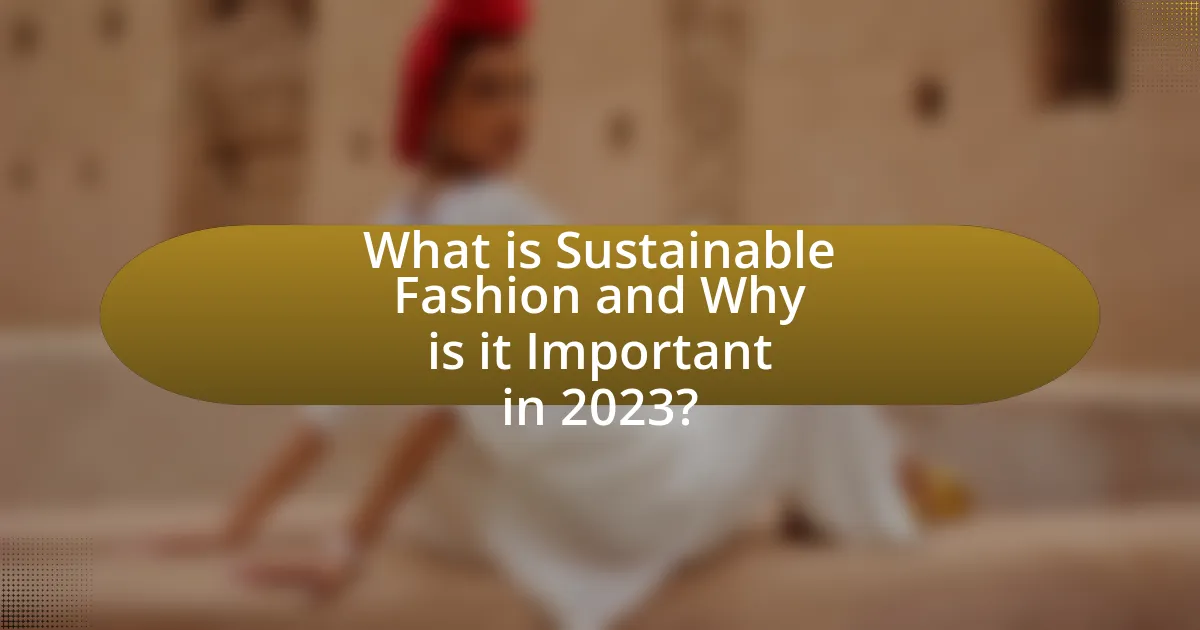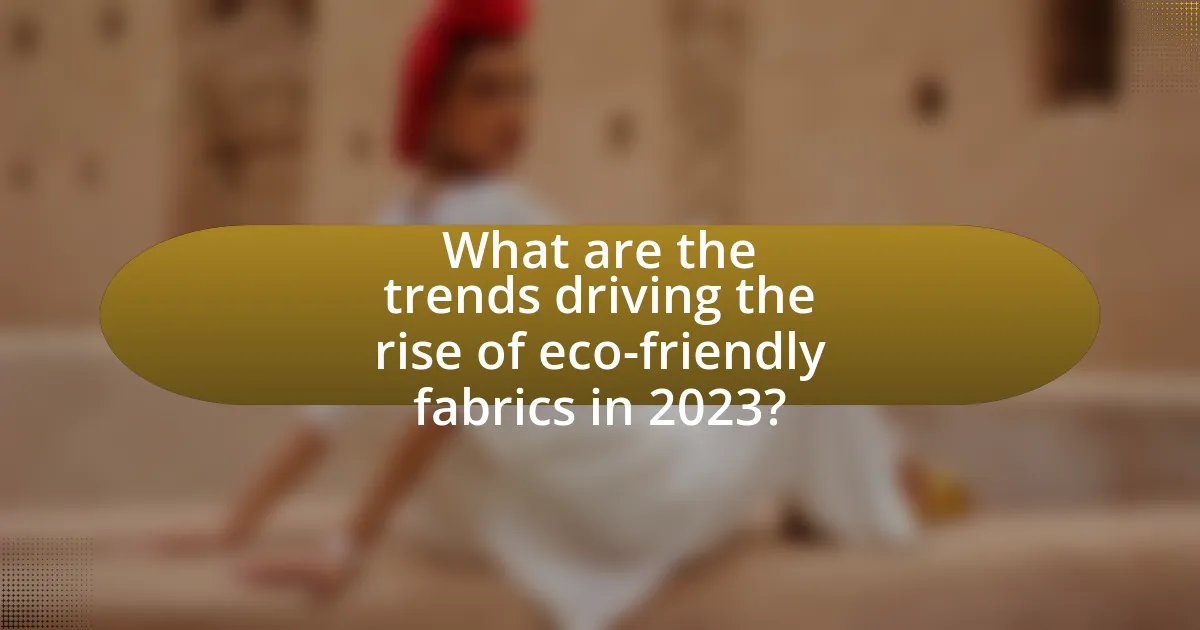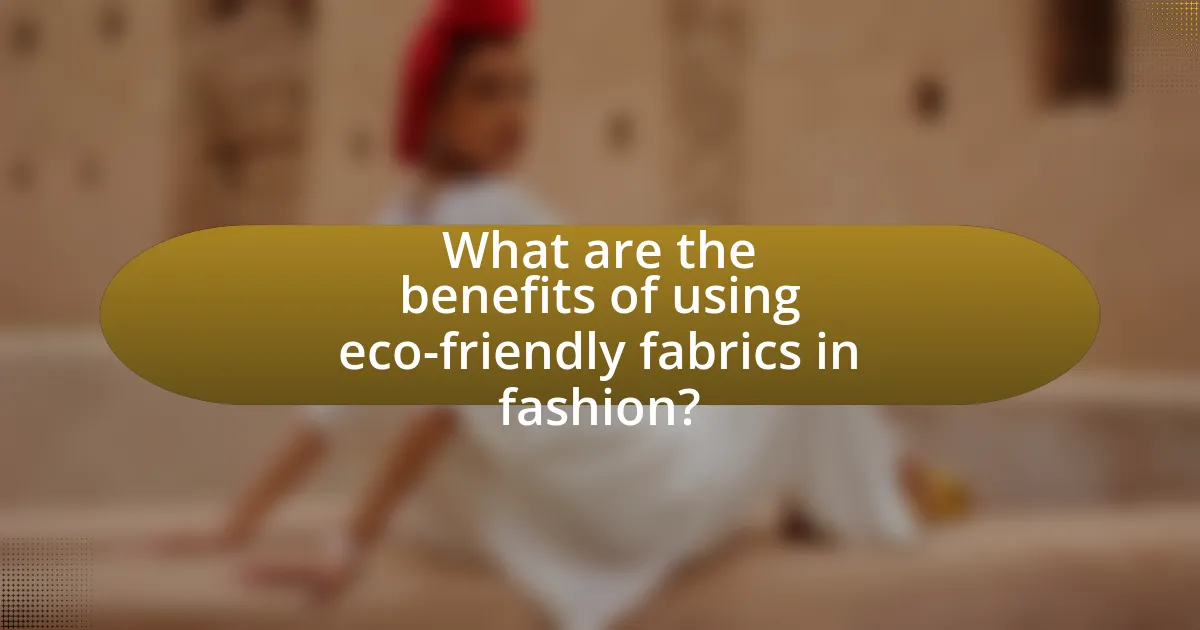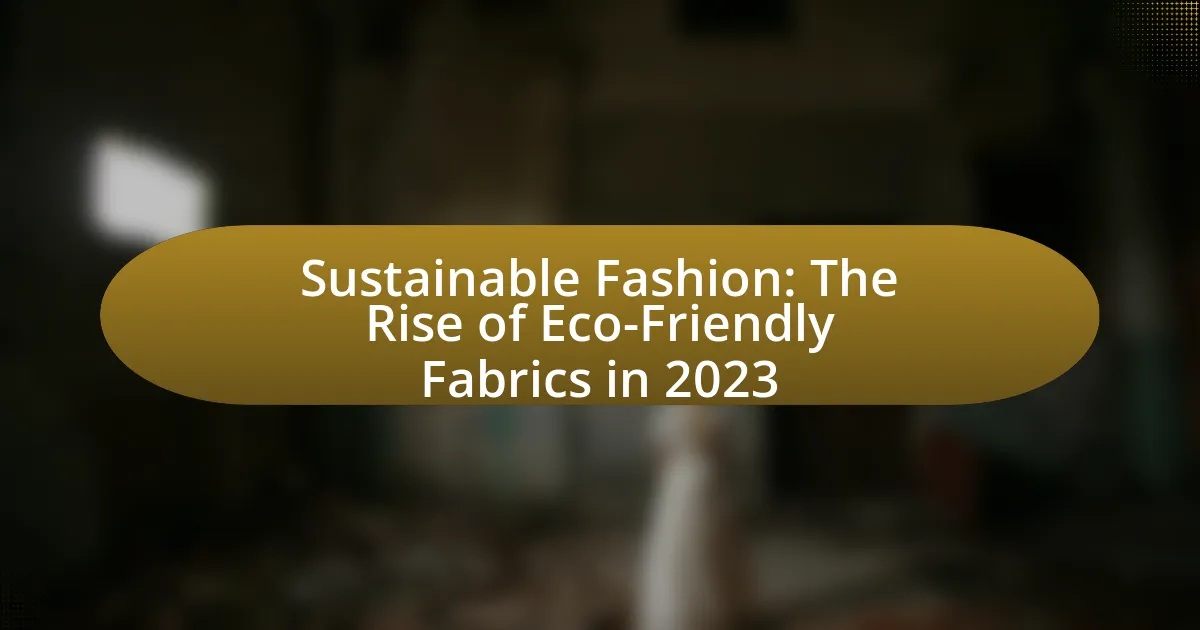Sustainable fashion, defined as clothing and accessories produced through environmentally friendly methods and ethical labor practices, is increasingly vital in 2023 due to the fashion industry’s significant contribution to global carbon emissions and waste. The article explores the differences between sustainable and traditional fashion, emphasizing key principles such as ethical production, resource efficiency, and circularity. It highlights the growing consumer awareness and demand for eco-friendly fabrics, such as organic cotton and recycled polyester, driven by a desire for sustainability. Additionally, the article discusses the challenges faced by manufacturers, the impact of social media on consumer preferences, and practical steps consumers can take to support sustainable fashion.

What is Sustainable Fashion and Why is it Important in 2023?
Sustainable fashion refers to clothing and accessories produced in environmentally friendly ways, prioritizing ethical labor practices and reducing waste. In 2023, it is important because the fashion industry is one of the largest polluters globally, contributing to significant carbon emissions and waste. According to the United Nations, the fashion sector accounts for about 10% of global carbon emissions, highlighting the urgent need for sustainable practices. Additionally, consumer awareness and demand for eco-friendly products have surged, with a report from McKinsey indicating that 67% of consumers consider sustainability when making a purchase. This shift emphasizes the necessity for brands to adopt sustainable practices to meet consumer expectations and mitigate environmental impact.
How does Sustainable Fashion differ from traditional fashion?
Sustainable fashion prioritizes environmental and social responsibility, while traditional fashion often emphasizes profit and rapid production. Sustainable fashion utilizes eco-friendly materials, such as organic cotton and recycled fabrics, reducing waste and pollution, whereas traditional fashion frequently relies on synthetic materials and mass production techniques that contribute to environmental degradation. For instance, the fashion industry is responsible for 10% of global carbon emissions, highlighting the significant impact of traditional practices compared to the more sustainable approaches being adopted in eco-friendly fashion.
What are the key principles of Sustainable Fashion?
The key principles of Sustainable Fashion include ethical production, resource efficiency, and circularity. Ethical production emphasizes fair labor practices and humane working conditions, ensuring that workers are treated justly throughout the supply chain. Resource efficiency focuses on minimizing waste and utilizing sustainable materials, such as organic cotton or recycled fabrics, to reduce environmental impact. Circularity promotes the idea of designing products for longevity and recyclability, encouraging consumers to recycle or upcycle garments rather than discarding them. These principles collectively aim to create a fashion industry that is environmentally responsible and socially equitable.
Why is consumer awareness crucial for Sustainable Fashion?
Consumer awareness is crucial for sustainable fashion because it drives demand for eco-friendly practices and products. When consumers are informed about the environmental and social impacts of their clothing choices, they are more likely to support brands that prioritize sustainability. For instance, a 2021 survey by McKinsey & Company found that 67% of consumers consider sustainability when making a purchase, indicating a significant shift towards eco-conscious buying behavior. This awareness not only influences purchasing decisions but also encourages brands to adopt sustainable practices, as they respond to consumer preferences for transparency and ethical production.
What role do eco-friendly fabrics play in Sustainable Fashion?
Eco-friendly fabrics are essential in sustainable fashion as they significantly reduce environmental impact. These materials, such as organic cotton, hemp, and recycled polyester, are produced with minimal use of harmful chemicals and resources, promoting a more sustainable production process. For instance, organic cotton uses 91% less water than conventional cotton, highlighting its role in conserving water resources. Additionally, eco-friendly fabrics often utilize renewable resources and biodegradable materials, which help decrease waste in landfills. The adoption of these fabrics is crucial for brands aiming to meet consumer demand for sustainable practices, as evidenced by a 2022 survey indicating that 66% of global consumers are willing to pay more for sustainable brands.
What are the most popular eco-friendly fabrics in 2023?
The most popular eco-friendly fabrics in 2023 include organic cotton, Tencel (lyocell), hemp, and recycled polyester. Organic cotton is favored for its reduced pesticide use and sustainable farming practices. Tencel, made from sustainably sourced wood pulp, is known for its biodegradability and low environmental impact. Hemp is recognized for its minimal water requirements and ability to grow in diverse climates, making it a highly sustainable option. Recycled polyester, derived from post-consumer plastic bottles, helps reduce waste and energy consumption in fabric production. These fabrics are increasingly adopted in the fashion industry due to their environmental benefits and consumer demand for sustainable options.
How do eco-friendly fabrics impact the environment compared to conventional fabrics?
Eco-friendly fabrics significantly reduce environmental impact compared to conventional fabrics. Conventional fabrics, such as polyester and cotton, often require extensive water usage, harmful pesticides, and fossil fuels for production, leading to pollution and resource depletion. In contrast, eco-friendly fabrics, like organic cotton and Tencel, utilize sustainable farming practices, reduce water consumption by up to 90% in some cases, and are biodegradable, minimizing landfill waste. Studies indicate that organic cotton farming can reduce greenhouse gas emissions by 46% compared to conventional cotton farming. Thus, eco-friendly fabrics contribute to a more sustainable fashion industry by lowering pollution and conserving natural resources.

What are the trends driving the rise of eco-friendly fabrics in 2023?
The trends driving the rise of eco-friendly fabrics in 2023 include increased consumer awareness of environmental issues, advancements in sustainable textile technology, and regulatory pressures for sustainable practices. Consumers are increasingly prioritizing sustainability, with a 2022 survey indicating that 66% of global consumers are willing to pay more for sustainable brands. Innovations in textile production, such as the development of biodegradable materials and recycled fibers, are making eco-friendly options more accessible and appealing. Additionally, governments and organizations are implementing stricter regulations on textile waste and pollution, pushing brands to adopt sustainable practices.
How are consumer preferences influencing fabric choices?
Consumer preferences are significantly influencing fabric choices by driving demand for sustainable and eco-friendly materials. As awareness of environmental issues increases, consumers are prioritizing fabrics made from organic, recycled, or biodegradable sources. For instance, a 2023 survey by McKinsey & Company found that 67% of consumers consider sustainability when making fashion purchases, leading brands to adopt materials like Tencel, organic cotton, and recycled polyester to meet this demand. This shift not only reflects changing consumer values but also compels manufacturers to innovate in fabric production to align with these preferences.
What demographic is most interested in eco-friendly fabrics?
The demographic most interested in eco-friendly fabrics is primarily millennials and Gen Z consumers. These age groups, particularly those aged 18 to 35, show a strong preference for sustainable products, with studies indicating that over 70% of millennials are willing to pay more for eco-friendly options. This interest is driven by heightened awareness of environmental issues and a desire for ethical consumption, as evidenced by market research from organizations like Nielsen, which found that 66% of global consumers are willing to pay more for sustainable brands.
How do social media and influencers affect the popularity of eco-friendly fabrics?
Social media and influencers significantly enhance the popularity of eco-friendly fabrics by promoting sustainable fashion trends to a broad audience. Influencers leverage platforms like Instagram and TikTok to showcase eco-friendly clothing, often highlighting the environmental benefits and ethical production processes associated with these fabrics. For instance, a study by the Global Fashion Agenda in 2021 indicated that 66% of consumers are influenced by social media when making fashion purchases, particularly in the sustainable sector. This visibility not only raises awareness but also drives consumer demand, as followers are more likely to purchase products endorsed by trusted figures in their social circles.
What innovations are emerging in eco-friendly fabric production?
Innovations in eco-friendly fabric production include the development of bio-based materials, such as fabrics made from organic cotton, hemp, and recycled polyester. These materials significantly reduce environmental impact by utilizing sustainable farming practices and minimizing waste. Additionally, advancements in dyeing techniques, such as waterless dyeing and natural dyes, are gaining traction, further decreasing water usage and chemical pollution. Research indicates that the global market for sustainable textiles is projected to grow, driven by consumer demand for environmentally responsible products, highlighting the importance of these innovations in the fashion industry.
How are technology and sustainability being integrated in fabric manufacturing?
Technology and sustainability are integrated in fabric manufacturing through the use of innovative processes and materials that reduce environmental impact. For instance, advancements in digital printing technology minimize water usage and chemical waste compared to traditional dyeing methods. Additionally, the development of bio-based and recycled fibers, such as those derived from post-consumer plastics, exemplifies how manufacturers are shifting towards sustainable raw materials. According to a report by the Ellen MacArthur Foundation, transitioning to a circular economy in fashion could reduce greenhouse gas emissions by 44% by 2030, highlighting the effectiveness of these technological integrations in promoting sustainability.
What are the challenges faced by manufacturers of eco-friendly fabrics?
Manufacturers of eco-friendly fabrics face several challenges, including higher production costs, limited availability of sustainable raw materials, and consumer awareness. The production costs for eco-friendly fabrics are often higher due to the need for specialized processes and materials, which can deter manufacturers from fully transitioning to sustainable practices. Additionally, the availability of sustainable raw materials, such as organic cotton or recycled fibers, is often limited, leading to supply chain constraints. Furthermore, consumer awareness and demand for eco-friendly products can be inconsistent, making it difficult for manufacturers to predict market trends and invest in sustainable innovations effectively.

What are the benefits of using eco-friendly fabrics in fashion?
The benefits of using eco-friendly fabrics in fashion include reduced environmental impact, improved sustainability, and enhanced consumer appeal. Eco-friendly fabrics, such as organic cotton and Tencel, are produced with less water and fewer chemicals, which minimizes pollution and conserves natural resources. According to a study by the Textile Exchange, the use of organic cotton can reduce water usage by up to 91% compared to conventional cotton. Additionally, eco-friendly fabrics often attract environmentally conscious consumers, leading to increased brand loyalty and market share. This shift towards sustainable materials aligns with the growing demand for ethical fashion, as reported by the Global Fashion Agenda, which indicates that 66% of consumers are willing to pay more for sustainable brands.
How do eco-friendly fabrics contribute to environmental sustainability?
Eco-friendly fabrics contribute to environmental sustainability by reducing resource consumption and minimizing pollution during production. These fabrics, often made from organic materials like cotton, hemp, or recycled fibers, require less water and energy compared to conventional textiles. For instance, organic cotton uses 91% less water than traditional cotton farming, significantly lowering the environmental impact. Additionally, eco-friendly fabrics are often biodegradable, which helps reduce landfill waste and pollution. According to a study by the Textile Exchange, the use of sustainable materials can decrease greenhouse gas emissions by up to 30%. This evidence demonstrates that eco-friendly fabrics play a crucial role in promoting a more sustainable fashion industry.
What are the long-term benefits of choosing eco-friendly fabrics for consumers?
Choosing eco-friendly fabrics offers consumers long-term benefits such as reduced environmental impact, improved health, and enhanced durability. Eco-friendly fabrics, made from sustainable materials like organic cotton or recycled polyester, significantly lower carbon emissions and water usage compared to conventional fabrics, contributing to a healthier planet. Additionally, these fabrics often contain fewer harmful chemicals, promoting better health for consumers by reducing exposure to toxins. Furthermore, eco-friendly fabrics tend to be more durable, leading to longer-lasting garments that reduce the frequency of purchases, ultimately saving consumers money over time. Studies indicate that sustainable fashion choices can decrease the overall ecological footprint of the clothing industry, reinforcing the positive impact of eco-friendly fabric selection.
How do eco-friendly fabrics enhance brand reputation for fashion companies?
Eco-friendly fabrics enhance brand reputation for fashion companies by demonstrating a commitment to sustainability and ethical practices. This commitment resonates with environmentally conscious consumers, leading to increased brand loyalty and positive public perception. According to a 2021 survey by McKinsey & Company, 67% of consumers consider sustainability when making purchasing decisions, indicating that brands utilizing eco-friendly materials can attract a larger customer base. Furthermore, companies that prioritize sustainable practices often receive favorable media coverage, which further elevates their reputation in the competitive fashion industry.
What are the potential drawbacks of eco-friendly fabrics?
Eco-friendly fabrics can have several potential drawbacks, including higher production costs, limited availability, and durability issues. The higher production costs often arise from the use of sustainable materials and ethical manufacturing processes, which can make eco-friendly fabrics more expensive than conventional options. Limited availability can restrict consumer choices, as not all retailers stock a wide range of eco-friendly fabrics. Additionally, some eco-friendly fabrics may not be as durable as traditional materials, leading to concerns about their longevity and the frequency of replacement, which can negate some of the environmental benefits.
How do costs compare between eco-friendly and traditional fabrics?
Eco-friendly fabrics generally have higher costs compared to traditional fabrics. This price difference arises from the more expensive raw materials, sustainable production processes, and lower economies of scale associated with eco-friendly textiles. For instance, organic cotton can cost up to 20% more than conventional cotton due to the absence of synthetic pesticides and fertilizers, as reported by the Textile Exchange in their 2021 Organic Cotton Market Report. Additionally, the labor-intensive methods often used in sustainable fabric production contribute to increased costs.
What are the limitations in the performance of eco-friendly fabrics?
Eco-friendly fabrics often exhibit limitations in durability, moisture-wicking ability, and color retention compared to conventional fabrics. For instance, organic cotton, while sustainable, tends to wear out faster than synthetic alternatives, leading to a shorter lifespan of garments. Additionally, many eco-friendly materials, such as hemp or bamboo, may not provide the same level of moisture management as polyester, which can affect comfort during physical activities. Furthermore, natural dyes used in eco-friendly fabrics may fade more quickly than synthetic dyes, impacting the aesthetic longevity of the clothing. These performance limitations can hinder the widespread adoption of eco-friendly fabrics in the fashion industry.
What practical steps can consumers take to support sustainable fashion?
Consumers can support sustainable fashion by choosing to buy from brands that prioritize eco-friendly materials and ethical production practices. This includes researching companies that use organic, recycled, or upcycled fabrics, as well as those that ensure fair labor conditions. According to a 2021 report by McKinsey & Company, 66% of consumers are willing to pay more for sustainable brands, indicating a growing demand for responsible fashion. Additionally, consumers can reduce their environmental impact by buying second-hand clothing, participating in clothing swaps, and properly recycling garments at the end of their life cycle. These actions collectively contribute to a more sustainable fashion industry.
How can consumers identify truly sustainable brands?
Consumers can identify truly sustainable brands by examining their transparency, certifications, and supply chain practices. Brands that openly share information about their sourcing, production processes, and environmental impact demonstrate a commitment to sustainability. Certifications such as Global Organic Textile Standard (GOTS) or Fair Trade indicate adherence to recognized sustainability standards. Additionally, brands that prioritize ethical labor practices and use eco-friendly materials, such as organic cotton or recycled fabrics, further validate their sustainability claims. Research shows that consumers increasingly prefer brands with clear sustainability practices, as evidenced by a 2021 Nielsen report indicating that 73% of global consumers are willing to change their consumption habits to reduce environmental impact.
What are some tips for incorporating eco-friendly fabrics into personal wardrobes?
To incorporate eco-friendly fabrics into personal wardrobes, prioritize purchasing clothing made from sustainable materials such as organic cotton, hemp, and Tencel. These fabrics are produced with less environmental impact compared to conventional textiles, as they often require fewer pesticides and less water. Additionally, consider supporting brands that are transparent about their sourcing and production processes, as this ensures that the fabrics are genuinely eco-friendly. Research shows that the global organic cotton market is projected to grow significantly, indicating a rising consumer demand for sustainable options. By choosing eco-friendly fabrics, individuals contribute to reducing the fashion industry’s carbon footprint and promoting sustainable practices.

Leave a Reply